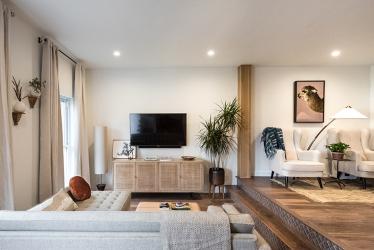Classic
Sunken living spaces are a classic. As it states above, they have been revived from the past. This indicates that it is a trend that will come and go but never necessarily going away. Something such as a sunken living space that can be brought back from the past shows a sense of design sustainability. Sunken living areas do limit your ability to reconfigure furniture layouts; on the other hand it does make the room feel bigger. Having the furniture steps below the line of vision tricks your eye into feeling that the space is larger than it really is. This living space design does tend to cost more, making people shy away from taking that route. However, it is a great way to ground the space, making it feel more intimate. Overall, sunken living spaces aren’t going anywhere making it a classic. Savannah Sells, Youtopia Designs
I have a house from the 1930s and the sunken living room was a way of making the room seem grander as larger, Italian paladian doors could be added for more drama. It also allowed another area of the same place to be at the same level as the rest of the house so it could act as a place for a piano, band or other area for further entertaining. Additionally the seating pit has made a comeback as many homes in Palm Springs are reintroducing it as a conversation pit. A hang out. Almost a space within a space. Trend? It could be, but so many decades have used it to designate another area instead of just flooring changes or separating a space with a half wall or planted pots or a screen. Scott Tjaden, Tjaden Interior Design
Craze
Sunken living rooms were the rage in the '70s after their appearance in a few homes in 1920s. The conversation pit created a unique space that added drama because it increased the ceiling height, as well as intimacy because it could feel quite cozy, and more so with a fireplace. With today's aging population, it would be more of a trip hazard than an architectural significance,
although existing century modern homes that are being purchased today will most likely have this feature. Therefore it depends on the buyer, and how they fit the home. I do not think this trend continues into present day new construction, keeping the housing market open to all buyers. Georgine O’Donnell, O’DESIGNS
I don’t view sunken living spaces as classic, but the style does return every once in a while. Sinking a room makes the ceiling higher and that was the idea when it started. I liked the look when it was being built in the late sixties and seventies. Now that we are more conscious of the need for accessibility, I do not think it is a good feature. Linda K. Kusmer, Interior Design Consultant
Sunken living spaces were designed to sit below floor level, and they define a space without needing walls. They are sometimes called conversation pits. They became popular in the 1960s and 1970s primarily due to the Dick Van Dyke show. Sunken spaces can be challenging to maneuver around, difficult to step-up and to step-down, and furniture placement can be tricky. Sunken living spaces are dated, awkward and completely passé. They can be reconstructed to rise to floor level but that can be pricey. Sunken living spaces in older houses have a bit of charm to them because they maintain the integrity of the era of the house; however, it would be best if they remained in that era. Barbara Collins AKBD, Allied ASID, Barbara Collins Interior Design





